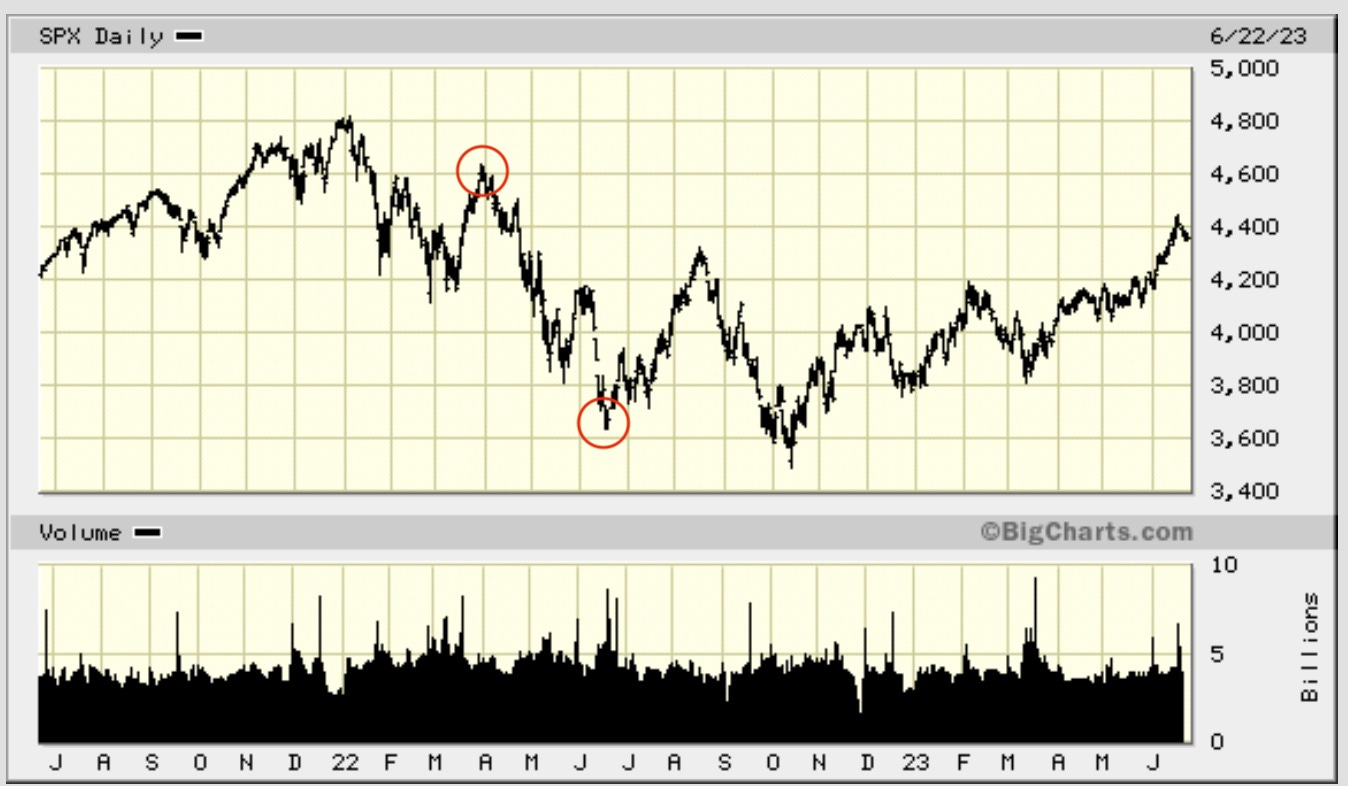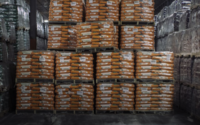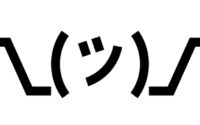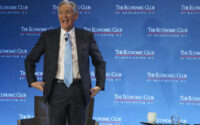You Bet Your Shorts the Market is Falling
Stocks are falling again. Even the NASDAQ is down. Short bets haven’t been this high since April ’22 — a month of decline that began exactly at the pinnacle of a major bull-trap rally in the midst of what would eventually prove to be a huge bear market. From the summit of that ambitiously steep rally, stocks went over a series of waterfalls for two-and-a-half months, ending up deep in a bear-market pool, only to attempt another major bear-market rally and then make an even deeper dive to end lower still four months later:

Of course, many prognosticators thought April’s excited rally after the January ’22 polar-bear plunge was the end of the bear before it even got declared a bear market. That was not to be so. This year, many thought the latest similarly steep (yet nowhere nearly as sizable) rally was the death knell of the bear, simultaneously ringing out that a new bull was born. However, with four days back in falling mode, their hopes are wavering … as well they should be, having been built on nothing but froth and denial of reality, over which reality will likely win again because it has more to deliver than the bulls can bear.
What is stomping the bull’s heads further into the dust this morning is Jerome Powell’s mere restatement of what he already made clear at the last FOMC meeting where the market foolishly rallied even more quickly upon hearing his warning. So, Powell added greater emphasis today to what he said back then, which was what I have said for as long as the bullheaded market has tried to rise on the entirely vain hopes of a Fed pivot — NO PIVOT! (Talk about a stubborn refusal to hear the obvious.) The Fed will not give up its inflation fight … at least, until the economy is destroyed. Its two mandates have it boxed into a legal corner. It must fight inflation, while jobs, in the Fed’s view, are scorching hot, giving it no alternative justification from its mandates that would allow it to back down on his bull fight with inflation.
I’ve said for months that the Fed’s misunderstanding (and, therefore, nearly everyone else’s misunderstanding since most economists and market talking heads just parrot whatever the Fed tells them) would keep it tightening until major economic (and stock) damage occurred. We already saw two of the largest bank failures in US history, second only to the cataclysmic crash of Washington Mutual during the Great Financial Crisis. Jamie Dimon, from his high throne, and me from my tiny patch of dirt on the ground have warned there are more bank failures to come due to the ongoing crash of commercial real-estate.
This time, Powell couldn’t have been more emphatic (in terms of normally reserved Fedspeak) since so many people refuse to believe him no matter how often he says it:
Jerome Powell would like to make one thing clear: the Federal Reserve is not done hiking interest rates.
Seeking to clear up confusion about policy and play down the significance of last week’s break in its 15-month credit tightening campaign, the Fed chair suggested officials were on course for two more rate increases this year.
Powell hammered home the message that the central bank was laser focused on reducing elevated inflation back to target despite Democrat lawmakers’ concerns that tighter credit will push up unemployment.
“The process of getting inflation down to 2% has a long way to go,” he told the House Financial Services Committee during a three-hour hearing….
Some Fed watchers were puzzled last week after policymakers held rates steady while at the same time forecasting that additional hikes would be needed to bring inflation to heel.
There was nothing to be puzzled about it if your head was not fogged with denial. It was so clear that I even said in advance they would pause BUT not be done, as their pause would merely be an attempt to reduce their rate of decent in hopes of making a soft landing. (Powell stated very clearly so that even a copilot jacked up on hopium could follow him this time, that the Fed was NOT stopping its rate hikes. It was SLOWING THE PACE, in order to allow more time to watch the dashboard for lagging economic indicators as Pilot Powell attempts to bring his 747 down for a landing. Which is not, regardless, how the Fed’s inverted landing is going to end up.)
Rather than drop from a 0.25% hike (typically the Fed’s smallest) to a 0.125% hike, the Fed doubled the time between its quarter-point hikes, effectively cutting the rate at which it is hiking by half. Powell said at the last meeting and he restated it now, Fed members expect another 0.50% rise in interest by the end of the year.
Powell, for his part, focused on the central bank’s so-called dot plot of forecasts, updated last week, which shows that half of the Federal Open Market Committee expects rates to rise another half point by the end of this year.
“That’s a pretty good guess of what will happen if the economy performs about as expected,” Powell said.
He asserted there was no inconsistency between officials holding rates steady last week while forecasting further increases later in the year.
“Given how far we’ve come, it may make sense to move rates higher but to do so at a more moderate pace,” he said.
This was never a hard message to understand in the first place, unless someone just doesn’t want to understand it, which, of course, speaks for many in the stock market who hear only what they want to hear.
And, of course, Powell repeatedly stressed that the banking system is “sound and resilient.”
That is what Fed heads and Treasury heads always say right before something breaks, because they wouldn’t be saying it at all, if there were not a lot of people afraid it was going to break because it IS going to break.
He did though say the banking supervisors were carefully watching developments in the commercial real estate market, where prices have recently begun falling, especially for office buildings that remain partly vacant in the wake of the pandemic. The Fed’s focus is on some smaller banks who have lent heavily to the sector, he said.
That is exactly the big scenario I brought home last week in my Deeper Dive article (“A Zombie Office Apocalypse Is Walking Your Way”). So, Powell agrees with me that this is the next area of concern, too — not that I feel any need for him to agree; it is just rare that he does. Therefore, when he agrees things are as fraught with trouble as I have been saying they are, then you know things must be bad. While he doesn’t listen to me, of course, you can be sure he listens to Jamie Dimon, the nation’s largest for-profit banker.
However …
The Fed chair said he saw no sign that the turmoil in the financial industry earlier this year was leading to severe pullback in bank lending — a so-called credit crunch – though he added it may be too soon for that to show up.
Let us remember that he also saw no sign of turmoil in the financial industry earlier this year mere days before major banks began to crash … and it is his job to see that … especially since the crash was due in large part to the deterioration in bank reserves the Fed had deliberately engineered. I say deliberately because even an understanding of Bonds 101 would tell anyone that the Fed’s run-off of Treasury bonds and its simultaneous increase in interest rates would predictably devalue the Treasury bonds Fed member banks hold in their Fed reserves, which is something Powell can easily watch, since he is the guy who banks those reserves for them.
He is without excuse for not seeing that coming. He’s a pilot who can’t see the runway he helped build on a clear day.
And then the coup de grâce to underscore what I have been saying:
Powell … played up the strength of the jobs market. He said the Fed was “over-achieving” on its goal of maximum employment, with demand for workers far outstripping supply.
You see, he actually sees the tight job market as being a situation where the Fed has over-achieved in creating a strong economy with a high demand for workers to where that high demand is outstripping supply, instead of seeing that the labor supply died off (whether due to Covid, vaccines or both) or retired during the Covid crisis and that the early retirees who are still living have no desire to return, and so dwindling labor cannot even meet declining demand.
One other thing I started saying about two months ago was that we are likely nearing the point where labor finally does start to capitulate to Powell’s tightening. Jobs have been drying up in layoffs as the economy declines again long enough now to diminish the gap between the nation’s damaged labor supply and the need for labor. So, it fits right in that another headline in today’s news shows that to be the case as the number of people applying for unemployment benefits has remained slightly elevated and steady for a third straight week at a twenty-month high.
That twenty month high, however, isn’t saying much, as it a high over a protracted period of ultra-low applications, and the three-month steady level that new application have risen to says the slight upward transition in unemployment is still sluggish. In fact, while tight labor is showing signs of turning in terms of initial applications for unemployment, the unemployment rate for those on continuing claims just dropped a little.
As for my claim of declining demand (for labor due to declining demand for the products and services labor produces), that brings us to our next set of stats that will become part of another Deeper Dive: Nearly all indicators in today’s headlines reveal an economy that is settling for a second dip into recession.
[ad_2]
Source link


